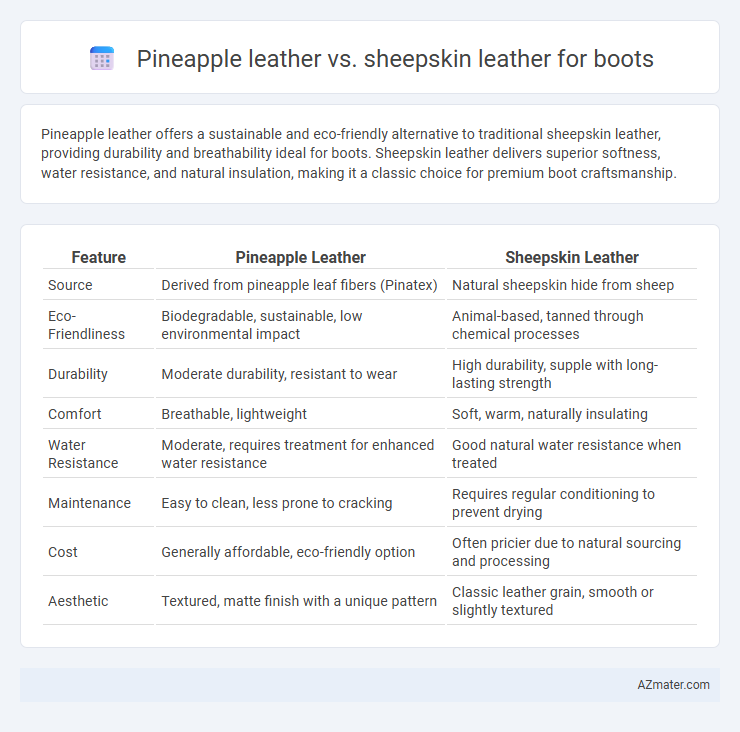Pineapple leather offers a sustainable and eco-friendly alternative to traditional sheepskin leather, providing durability and breathability ideal for boots. Sheepskin leather delivers superior softness, water resistance, and natural insulation, making it a classic choice for premium boot craftsmanship.
Table of Comparison
| Feature | Pineapple Leather | Sheepskin Leather |
|---|---|---|
| Source | Derived from pineapple leaf fibers (Pinatex) | Natural sheepskin hide from sheep |
| Eco-Friendliness | Biodegradable, sustainable, low environmental impact | Animal-based, tanned through chemical processes |
| Durability | Moderate durability, resistant to wear | High durability, supple with long-lasting strength |
| Comfort | Breathable, lightweight | Soft, warm, naturally insulating |
| Water Resistance | Moderate, requires treatment for enhanced water resistance | Good natural water resistance when treated |
| Maintenance | Easy to clean, less prone to cracking | Requires regular conditioning to prevent drying |
| Cost | Generally affordable, eco-friendly option | Often pricier due to natural sourcing and processing |
| Aesthetic | Textured, matte finish with a unique pattern | Classic leather grain, smooth or slightly textured |
Introduction to Pineapple Leather and Sheepskin Leather
Pineapple leather, also known as Pinatex, is an innovative plant-based material made from pineapple leaf fibers, offering a sustainable and eco-friendly alternative to traditional leathers. Sheepskin leather is prized for its soft texture, durability, and natural insulation, making it a popular choice for boots that require warmth and comfort. Both materials provide distinct benefits, with pineapple leather emphasizing environmental impact and sheepskin leather highlighting performance and luxurious feel.
Material Origins: How Pineapple Leather and Sheepskin Are Made
Pineapple leather, also known as Pinatex, originates from the cellulose fibers of pineapple leaves, which are harvested as a byproduct of pineapple farming, making it a sustainable and eco-friendly material. Sheepskin leather is derived from the tanned hide of sheep, undergoing processes such as soaking, tanning, and finishing to produce a soft, durable material traditionally used for boots. The distinct production methods highlight pineapple leather's plant-based, renewable source versus sheepskin leather's animal-based, processed origin.
Sustainability and Environmental Impact
Pineapple leather, derived from agricultural waste using biodegradable materials, offers a significantly lower environmental impact compared to traditional sheepskin leather, which involves resource-intensive livestock farming and chemical tanning processes. The production of pineapple leather reduces water consumption and greenhouse gas emissions while promoting circular economy principles by repurposing pineapple leaves. In contrast, sheepskin leather contributes to deforestation, high carbon footprints, and hazardous waste generation, making pineapple leather a more sustainable and eco-friendly choice for boots.
Durability and Performance in Boots
Pineapple leather, made from the durable fibers of pineapple leaves, offers high resistance to water and abrasion, making it an eco-friendly yet robust choice for boots. Sheepskin leather is renowned for its softness, breathability, and flexibility but tends to be less resistant to heavy wear and moisture compared to pineapple leather. In terms of durability and performance, pineapple leather surpasses sheepskin by providing longer-lasting protection and structural integrity in rugged conditions.
Comfort and Breathability Comparison
Pineapple leather offers superior breathability compared to sheepskin leather, as its natural fibrous structure allows for better air circulation, reducing heat buildup and moisture. Sheepskin leather provides excellent comfort through its soft, supple texture and natural insulation, making it ideal for temperature regulation and cushioning. Both materials ensure comfort, but pineapple leather excels in ventilation, while sheepskin leather stands out for its plush softness and warmth.
Design Versatility and Aesthetics
Pineapple leather offers lightweight flexibility and a unique textured surface that enhances modern, eco-friendly boot designs, appealing to fashion-forward consumers seeking sustainable materials. Sheepskin leather provides a soft, supple finish with a natural sheen, lending classic elegance and durability to boots that can easily transition from casual to formal wear. Both materials deliver distinct aesthetic qualities, with pineapple leather emphasizing innovative appeal and sheepskin highlighting timeless sophistication.
Cost and Market Availability
Pineapple leather, made from sustainable pineapple leaf fibers, typically costs less than traditional sheepskin leather due to lower raw material expenses and eco-friendly production processes. Sheepskin leather maintains higher market availability because of established supply chains and widespread use, while pineapple leather remains niche, with limited suppliers and boutique brands offering it. Consumers seeking affordable, sustainable alternatives often find pineapple leather boots a cost-effective but less readily available option compared to classic sheepskin leather boots.
Maintenance and Care Requirements
Pineapple leather, made from sustainable Pinatex fibers, requires gentle cleaning with a damp cloth and minimal water exposure to maintain its texture and prevent fiber damage. Sheepskin leather demands regular conditioning with specialized leather creams to prevent cracking and maintain softness, alongside avoiding prolonged moisture to deter mold and mildew. Both materials benefit from storage in a dry, cool environment, but pineapple leather's plant-based composition offers a more resilient and low-maintenance alternative for eco-conscious consumers.
Ethical Considerations and Animal Welfare
Pineapple leather offers a sustainable and cruelty-free alternative to traditional sheepskin leather, reducing the environmental impact and eliminating harm to animals in boot production. Sheepskin leather involves animal farming and slaughter, raising concerns about animal welfare, ethical sourcing, and resource-intensive processes. Choosing pineapple leather supports ethical fashion by promoting plant-based materials and minimizing wildlife exploitation.
Which Leather is Best for Your Boots?
Pineapple leather offers a sustainable, cruelty-free alternative with a lightweight, breathable texture ideal for eco-conscious boot buyers, while sheepskin leather provides superior softness, natural water resistance, and durability favored in traditional boot craftsmanship. Sheepskin excels in moisture-wicking properties and insulation, making it perfect for cold or wet conditions, whereas pineapple leather prioritizes environmental impact without compromising style. Choosing the best leather depends on whether durability and classic performance or sustainability and vegan materials align better with your boot-wearing needs.

Infographic: Pineapple leather vs Sheepskin leather for Boot
 azmater.com
azmater.com